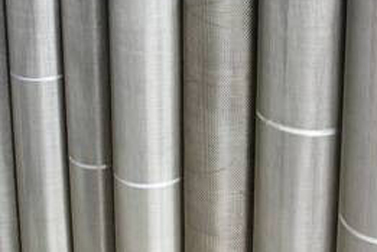Stainless steel wire mesh is also called stainless steel screen, stainless steel weaving wire mesh, stainless steel strainer, stainless steel filter mesh, stainless steel wide wire mesh, etc. Our stainless steel wire mesh products are generally made of stainless steel Type 201,302, 304, 304L, 310,310s,316, 316L, 321 and 430, etc.
For stainless steel and industrial wire cloth with woven wire mesh and wire mesh panels, weaving is everything. The weave determines how the wire cloth can be used and it's capacity. With this in mind, here is a list of the types of weave available when purchasing wire cloth-related products.
First, let's look at pre-curled tissues. These tissues are usually used for rougher wire and space cloth. The following is an overview of the three different types.
ㆍPre-Crimp - Generally, to add strength and stiffness to wire cloth, pre-curled tissue is curled (or folded so that the wires have small folds or ridges) before being woven. This allows the warp and weft wires to be placed securely and prevents them from moving unwantedly.
ㆍLocked crimp - Another type of pre-curled tissue is the locked crimp. This type of weave uses the grooves left behind during the crimping process to lock the braids together at the points where they intersect. This makes the wire stronger and further prevents movement.
ㆍInter-Crimp or Multiple Crimp - Finally, inter-crimp or multiple crimps offers another improvement on the basic crimp organization.
With this method, both warp and weft wires are crimped by means of additional crimps between the intersections. This technique is often required when weaving larger openings with fine threads. This process ensures that the warp and weft yarns are locked incorrectly and also helps to increase accuracy and stiffness.

This is the most common type of weave used for wire cloth. In this case, there is no pre-crimping before the wire is woven. Instead, the curling of the warp and weft yarns is the result of a plain tissue pattern that requires each weft yarn to pass above and below successive rows of warp threads.
In terms of filter cloth, the types of the weave to be aware of are as follows.
ㆍPlain Dutch weave - This type of weave uses a similar technique to plain weave. However, the warp threads have a larger diameter than the weft threads. The lighter skeins are brought closer together to form a dense filter. This weave is wedge-shaped or tapered at the opening.
ㆍDutch twill - This filter fabric consists of a combination of twill and Dutch weave. This uses a technique where the larger diameter warp threads are passed above and below the smaller weft threads. This results in the screens being closer together and results in a tightly woven filter fabric with a wedge or tapered openings.
Stainless Steel Wire Mesh
ㆍTwill Dutch Double - This is similar to Dutch twill weave. However, due to the correct choice of wire size, the weft threads overlap before they are driven into their tight position. This results in a double thread per inch in the weft direction.
ㆍStranded - With this type of weave, both the weft and warp are made from separate threads, rather than a single thread. This produces a twill pattern, which makes the mesh very strong and tight.
The twill weave forms a wire fabric in which each weft and warp thread passes through two adjacent wires in turn; this occurs in both the weft and warp directions. This pattern allows heavier wires to be woven into various types of net.
ㆍWhen it comes to wire cloth, weaving is everything
ㆍPre-curled tissue for wire and space cloth
ㆍPlain tissue is most commonly used for wire cloth
Do you have more questions about our stainless steel wire mesh or the other different metal alloy options that we offer? We’d be happy to answer all of your questions. If you want to get more information about high-quality stainless steel wire mesh wholesale, welcome to contact us today or request a quote.
Copyright © Landyoung Group Co., Ltd. All Rights Reserved. | Sitemap